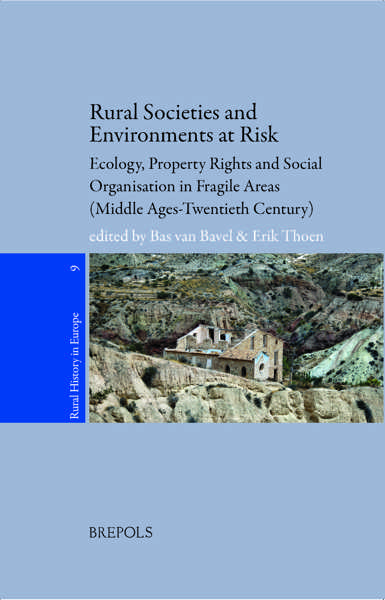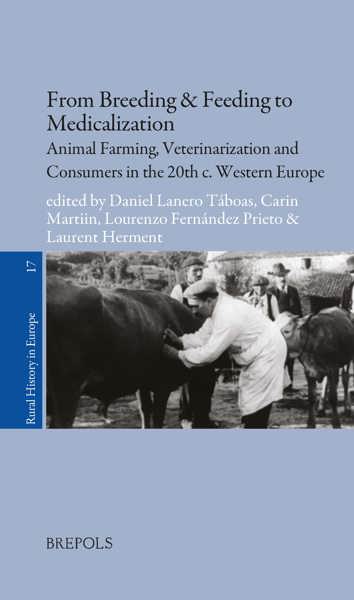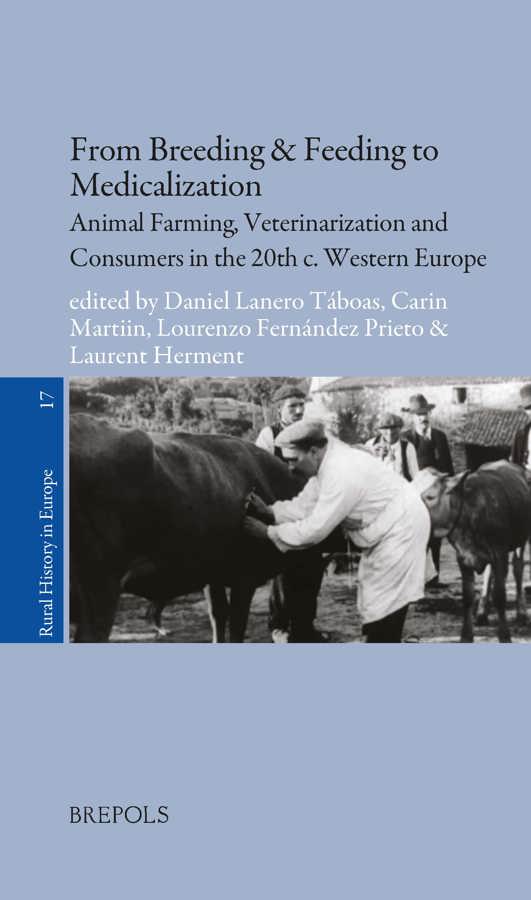
From Breeding & Feeding to Medicalization
Animal Farming, Veterinarization and Consumers in Twentieth-Century Western Europe
Daniel Lanero Taboas, Carin Martiin, Lourenzo Prieto, Laurent Herment (eds)
- Pages: 360 p.
- Size:156 x 234 mm
- Illustrations:33 b/w, 21 tables b/w.
- Language(s):English
- Publication Year:2023
- € 104,00 EXCL. VAT RETAIL PRICE
- ISBN: 978-2-503-58915-2
- Paperback
- Available
- € 104,00 EXCL. VAT RETAIL PRICE
- ISBN: 978-2-503-58916-9
- E-book
- Available
- Contains contributions in Open Access
This book aims at gathering a large set of expertise. agronomy, veterinary medicine, microbiology, history of sciences, economic and cultural history, and sociology.
Daniel Lanero Táboas, lecturer at University of Santiago de Compostela/CISPAC, focused on Social History of Rural World, Fascism and Transitions to Democracy.
Carin Martiin, docent and agronomist. Agrarian history, Swedish University of Agriculture.
Lourenzo Fernández Prieto is Professor at University of Santiago de Compostela/CISPAC, focused on social and technological Agrarian History.
Laurent Herment is researcher at CNRS, he studies the emergence of agri-food and agri-industry chain during the nineteenth century.
To fully understand the changes in European animal husbandry during the long twentieth century, it is necessary to examine all aspects of the food chain devoted to supplying proteins and fats to a growing population. Indeed, the twentieth century saw great changes in animal husbandry - towards a market-oriented, intensified and specialized production. This influenced and was influenced by policies, trade, aspects of animal and public health, food supply issues, aims in animal breeding, development of production systems, principles in feeding and impact of producer cooperatives.
Because it is not possible to apprehend all these global changes from a rural point of view, this book aims to bring together many different expert perspectives in fields such as: agronomy, veterinary medicine, microbiology, history of sciences, economic and cultural history, and sociology. Taking into account both national idiosyncrasies and changes from an international perspective, the book gathers scientists from Italy, Spain, France, England, The Netherlands and Sweden.
The first part of the book will be devoted to the evolution of animal husbandry and commercialization from the end of the nineteenth century to the beginning of the twenty-first century. The second part of the book is devoted to the increasing medicalization of this sector with a special focus on the role of veterinarians and on the increasing uses of antibiotics.
1. Introduction
Laurent Herment, Daniel Lanero Taboas, Lourenzo Fernandez Prieto, Carin Martiin.
Part 1: Animal husbandry and dairy production and consumption
2. Figuring the Past: statistics as cultural artefacts in British agri-culture from the mid-nineteenth to the mid-twentieth century
Karen Sayer
3. Shifting feeding strategies in Swedish dairy farming, from the late 19th to the late 20thc.
Carin Martiin
4. The devil is always in details. Good and bad oilseed cakes at the end of the nineteenth century in France and Italy
Luca, Andreoni &Laurent Herment
5. Telmo Otero Rodríguez & Daniel Lanero Táboas, HISTAGRA, University of Santiago de Compostela
‘Cattle improvement and dairy specialization. The long transition from cattle multifunction to dairy production in Galicia (1920-1975)’
6. Marco Marigliano, PhD Stud. Università Cattolica del Sacro Cuore (Piacenza-Cremona), Italy
‘Innovations and associations in the Italian dairy cattle breeding. The case study of the Frisona Italiana (1946-1975)’
7. Ronald Plantinga, Merijn Knibbe & Marijn Molema, Fryske Akademy, the Netherlands
‘Complementary paths of bio-based productivity growth in Dutch Dairying, 1950-1990’
8. Fernando Collantes, University of Zaragoza, Spain
‘From massification to upgrading a long run view of the recent trends in dairy consumption in Spain’
Part 2: Veterinarians and antibiotics
9. Karl Bruno, Royal Institute of Technology (KTH), Stockholm
‘Reproduction Work: Veterinarians, Artificial Insemination, and the Production of Reproductive Health in Swedish Dairy Cattle, 1910-1960’
10. Diego Conde Gómez & Lourenzo Fernández Prieto, HISTAGRA, University of Santiago de Compostela.
‘The role of the Veterinary profession in the improvement of livestock in Contemporary Spain (1910-1936)’
11. Kristina Nordéus, DVM, PhD; Agricultural Counsellor; Permanent Representation of Sweden to the EU (Vet).
“When Science is not enough Antibiotic growth promoters and the precautionary principle within the European Union”
12. Annick Jacq, CNRS EA 610 Université Paris Saclay (microbiologist).
Centre National de la Recherche Scientifique, Groupe d'Histoire et de Diffusion des Sciences d'Orsay, Etudes sur les Sciences et les Techniques, EA 1610, Université Paris-Sud.
“Too much antibiotic in aquaculture too? The emergence of a public problem in France retraced through actors’ discourses”
13. Alexandra Waluszewski, Dept. of Economic History, Uppsala University (Economist)
‘Who is paying? On a system innovation compensating for (over)use of antibiotics in Swedish pig meat production’
14. Rise and fall of ecopathology. The thwarted development of a preventive approach to animal health (France, 1970s-1980s)
Nicolas Fortané




